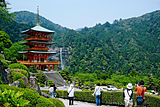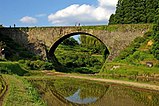Important Cultural Property (Japan)
Appearance

An Important Cultural Property (重要文化財, jūyō bunkazai)[note 1] is an item officially classified as Tangible Cultural Property by the Japanese government's Agency for Cultural Affairs (Ministry of Education, Culture, Sports, Science and Technology) and judged to be of particular importance to the history, arts, and culture of the Japanese people.[1]
Classification of Cultural Properties
To protect the
Registered Cultural Properties
.
Cultural Properties are classified according to their nature. Items designated as Tangible Cultural Properties (as opposed to
National Treasures (国宝), for especially valuable items. The designation can take place at the city (市定重要文化財, city designated Important Cultural Property), prefectural (県定重要文化財, prefecturally designated Important Cultural Property) or national (国定重要文化財, nationally designated Important Cultural Property) level. In this last case the designating agency is often not specified. Varying levels of designation can coexist. For example, Sankei-en, a traditional Japanese-style garden in Naka Ward, Yokohama, is both city and nationally designated as an Important Cultural Properties.[2]
Examples
-
ANara
-
Nihon Bridge in Nihonbashi, Tokyo
-
Holy Resurrection Cathedral in Tokyo
-
Kamakura, Kanagawaprefecture
-
Meiji Seimei Kan in Tokyo
-
Hatsuhana tea caddy, one of the special tea utensils, kept at the Tokugawa Memorial Foundation
Lists of Important Cultural Properties of Japan
- List of Important Cultural Properties of Japan (Asuka period: structures)
- List of Important Cultural Properties of Japan (Nara period: structures)
- List of Important Cultural Properties of Japan (Heian period: structures)
- List of Important Cultural Properties of Japan (Kamakura period: structures)
- List of Important Cultural Properties of Japan (Shōwa period: structures)
- List of Important Cultural Properties of Japan (Okinawa: structures)
See also
- Cultural Properties of Japan
Notes
References
- ^ a b "Cultural Properties for Future Generations" (PDF). Administration of Cultural Affairs in Japan ― Fiscal 2009. Agency for Cultural Affairs. June 2007. Archived from the original (PDF) on 2009-03-27.
- ^ Yokohama Sankei Garden, Sankei-en's official site accessed on November 3, 2009 (in Japanese)
External links
Wikimedia Commons has media related to Important Cultural Property of Japan.










